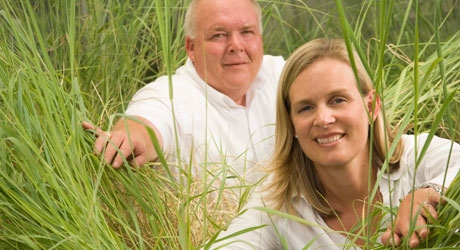Fill’er Up with Grassoline

By Jay Mayfield
Tennessee business people, farmers, scientists, and political leaders have begun to rally around a shared vision of a statewide economy powered by ethanol, but this fuel has a distinctly Tennessee twist. What sets Tennessee’s vision apart from other states with an eye toward biofuels is the commitment to make that ethanol from sources other than corn—mostly from a hardy plant called switchgrass.
And what will they call the fuel? Grassoline, of course.
The effort, known as the Tennessee Biofuels Initiative, took a major step forward recently with the announcement of a site for a demonstration plant that will produce the first batches of Tennessee-grown grassoline within just a few years. Converting switchgrass into ethanol is a complex process—more difficult than converting corn. A major part of the Biofuels Initiative’s work is to make that process less expensive and more efficient, and the heart of that effort is the creation of this new facility to convert switchgrass to ethanol on a large scale.
The plant, to be built in partnership with national biofuels leader Mascoma Inc., will operate on about one-tenth the scale of a full commercial production facility. UT announced in August that the plant would be in Monroe County at the Niles Ferry Industrial Park.
“The site sits in the heart of a productive farm region where the agricultural community has shown interest in the biofuels effort,” said Dr. Kelly Tiller, director of external operations for the UT Office of Bioenergy Programs. An agricultural economist, Tiller is also one of the authors of the business model for the Biofuels Initiative.
“The site has all needed infrastructure to support the facility and is close enough to Knoxville to allow easy movement by researchers and students to and from the site,” Tiller explained.
Construction on the demonstration plant, expected to cost roughly $40 million, is expected to begin by the start of 2008, with a goal of reaching its full production level of 5 million gallons of grassoline each year by the middle of 2010.
Just as the sugars extracted from grapes become the ethanol in wine, the sugars—mostly in cellulose—inside switchgrass are what become ethanol for fuel. Researchers at UT have been working on methods to more easily convert, extract, and separate those sugars for conversion into ethanol.
The challenge is that, unlike the sugars stored around a plant’s seeds in a fruit like grapes or a vegetable like corn, the sugars in switchgrass are contained within the plant’s tough cell walls. Scientists can approach that challenge in a couple of ways.
One approach is to alter the plant itself, finding ways to make genetic changes that allow the cells to be broken down more easily. UT is part of a recently announced $125-million joint Bioenergy Research Center led by Oak Ridge National Laboratory that will focus on these issues. The center will be housed in the UT–ORNL Joint Institute for Biological Sciences.
The other approach is to find ways to improve upon the chemical and biological processes that are currently used to free and convert the sugar found in switchgrass and other forms of biomass, like wood chips.
The second approach will be the work of the demonstration facility. UT and Mascoma scientists will use the plant to fine-tune and refine both the conversion process and the logistics of moving the switchgrass from the field to the plant. By creating a working model, they hope to show farmers and private industry that the model can be recreated across the state in full-scale facilities.
The plant will also serve as a massive research site for UT, creating a one-of-a-kind laboratory for students and faculty researchers to better understand and work with the methods used to convert biomass into ethanol. Part of the Biofuels Initiative plan is to create more college graduates who are prepared to work in the emerging biofuels industry.
Some have likened the challenges of creating such an industry from scratch to another well-known causality conundrum—the chicken or the egg. To sustain a facility like the one to be built, there must be enough switchgrass grown in the surrounding area to keep the plant in production. But to convince farmers to commit their land to switchgrass, they have to know that they’ll have a place to sell it once it grows.
To jump-start the process, farmers will receive incentives to plant switchgrass, which takes 3 years to mature for harvesting. Tiller and others involved with UT’s biofuels work have made regular visits to farmers around the state to help inform and educate them about the goals of the Biofuels Initiative, as well as about the basics of producing switchgrass.
They point to a study by UT agricultural economist Dr. Daniel de la Torre Ugarte showing that Tennessee has more potential in terms of climate and soil conditions to support a major switchgrass crop than nearly any other location in the U.S.
The demonstration plant is likely to produce its first fuel from wood chips and other biomass as the first plantings of switchgrass in and around the Monroe County site grow to maturity. The process relies on production facilities and switchgrass crops being located near each other to reduce the cost of transporting the crop to the plant.
According to Tiller and other UT researchers, this facility is a vitally important first step in a process they believe has the potential to change the fundamental economy of the state for decades to come. Their optimism is shared by Governor Phil Bredesen.
“We are a biomass state,” said Bredesen when he announced the funding for the demonstration plant in early 2007. “We have the right conditions, climate, and resources to grow virtually unlimited quantities of biomass. We also have the scientific and research communities in our universities and laboratories required to help us realize this potential in a way that can be truly transformational for our state and our economy.”